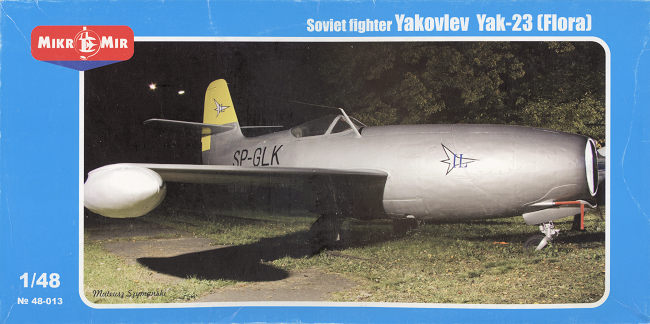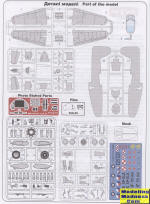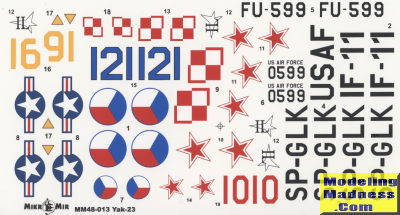
Mikr Mir 1/48 Yak-23
| KIT #: | 48013 |
| PRICE: | 27 Euros plus shipping |
| DECALS: | Five options |
| REVIEWER: | Scott Van Aken |
| NOTES: | Short run kit with p.e. fret |

| HISTORY |
The Yakovlev Yak-23 (Russian: Яковлев Як-23; USAF/DoD reporting name Type 28), NATO reporting name Flora) was an early Soviet jet fighter with a straight wing. It was developed from the Yak-17 in the late 1940s and used a reverse-engineered copy of a British engine. It was not built in large numbers as it was inferior in performance to the swept-wing Mikoyan-Gurevich MiG-15. Many Yak-23s were exported to the Warsaw Pact nations and remained in service for most of the 1950s, although some were still in use a decade later.
On 11 March 1947, the Council of People's Commissars ordered several design bureaux (OKB), included that of Alexander Yakovlev, to develop a single-seat, straight-winged jet fighter to be equipped with a single British Rolls-Royce Nene or Rolls-Royce Derwent turbojet engine. The aircraft should have a maximum speed of 950 kilometers per hour (590 mph) at sea level and a speed of 1,000 km/h (621 mph) at an altitude of 5,000 meters (16,400 ft). It should be able to climb to that altitude in 3.5 minutes or less and should have a maximum range of no less than 1,200 kilometers (750 mi). Alexander Yakovlev decided to develop two designs, the Yakovlev Yak-25 in accordance with the Ministry's order and a lightweight, more agile aircraft (the Yak-23) in the hopes that one or the other would win an order from the Ministry. Yakovlev's decision was a risky one as it could be construed as unauthorized use of state monies if discovered, which could have landed Yakovlev in a lot of trouble.
To minimize risk, the new aircraft used the same "pod-and-boom" layout as the earlier Yak-17 fighter, but the metal fuselage was redesigned as a semi-monocoque structure with the single-seat, unpressurized cockpit and its teardrop-shaped canopy positioned just above the trailing edge of the wing. Not coincidentally, this was also above the exhaust of the 1,590-kilogram-force (15.6 kN; 3,500 lbf) centrifugal-flow Klimov RD-500 engine, an unlicensed copy of the Derwent V. Fitted with tricycle landing gear, the main landing gear retracted inwards into the fuselage while the nose gear retracted forwards. Unlike the installation in the Yak-17, the Yak-23's forward landing gear was flush with the fuselage when retracted. The laminar-flow, two-spar, wing was mounted in the middle of the fuselage. It was equipped with slotted flaps and ailerons and had a modest 3° 30' dihedral. The horizontal stabilizers had 5° of dihedral. The pilot was protected by a bulletproof windscreen and the armored back of the ejection seat. The Yak-23 was equipped with five non-self-sealing fuel tanks in the fuselage that had a total capacity of 910 liters (200 imp gal; 240 U.S. gal) of fuel. In addition it could carry a pair of 195-liter (43 imp gal; 52 U.S. gal) drop tanks under the wingtips. The fighter was armed with two 23-millimeter (0.9 in) Nudelman-Rikhter NR-23 autocannon, each with 90 rounds.
Two prototypes and a static-test airframe were ordered and the aircraft first flew on 8 July 1947 with the Hero of the Soviet Union, Lieutenant Colonel Mikhail Ivanov, at the controls. While still involved in its manufacturer's flight testing, the first prototype participated in the flypast at Tushino Airfield on 3 August. The Yakovlev OKB concluded its testing on 24 September and turned over the second prototype for state acceptance trials on 22 October. Although the Yak-23 was accepted for series production, it was criticized of heavy aileron and rudder forces, lack of cockpit pressurization and heating and ventilation, protection for the pilot and weak armament. The test pilots did praise it as highly maneuverable, with a good acceleration and takeoff and climb capabilities thanks to a high thrust-to-weight ratio. The second prototype was modified afterwards to address some of these issues and successfully tested again in 1948.
Small numbers of Yak-23s were exported to Czechoslovakia (20 from 1949, named S-101), Bulgaria (from 1949), Poland (about 100, from 1950), Romania (62, from 1951). Poland and Czechoslovakia acquired licenses for the aircraft, but built the superior MiG-15 instead. Yak-23s were withdrawn by the late 1950s, except in Romania which used them for another decade.
| THE KIT |
 While
doing a bit of research on this kit, I came to find that the majority of the
parts in this kit are identical to those offered by Bilek. In fact, the Mikr Mir
kit includes a sprue the Bilek kit does not have and has a bit more
comprehensive photo etch fret. The common parts have identical sprue layouts.
While
doing a bit of research on this kit, I came to find that the majority of the
parts in this kit are identical to those offered by Bilek. In fact, the Mikr Mir
kit includes a sprue the Bilek kit does not have and has a bit more
comprehensive photo etch fret. The common parts have identical sprue layouts.
 Surface
detailing is fine, crisp panel lines, with somewhat large sprue attachment
points. There is a nicely done cockpit and this is where the p.e. is used with a
two part instrument panel, seat harness and rudder pedals on the fret. An
acetate sheet with instrument dials is included for the panel. This fret's seat
harness is something not included with the Bilek kit.
Surface
detailing is fine, crisp panel lines, with somewhat large sprue attachment
points. There is a nicely done cockpit and this is where the p.e. is used with a
two part instrument panel, seat harness and rudder pedals on the fret. An
acetate sheet with instrument dials is included for the panel. This fret's seat
harness is something not included with the Bilek kit.
The 'new' sprue in this kit contains a complete engine as well as new main landing gear legs. It also contains a pair of wing tip tanks that seem to have been omitted in the Bilek offering. This engine replaces what is a simple blanking plate offered in the other kit. I'm not sure how many folks are going to actually build the complete engine, but you'll need at least the body of it to help hold the front intake splitter.
Inner main gear wells have to be built up of three pieces before installing it in the fuselage while the wing wheel wells are a simple U shape that is trapped between the wings. The thin nose gear well is made up from the bottom of the two intake splitter halves. From the look of it, the trailing edges of the wings will have to be shaved down to get a proper thin edge. I'm not sure how much room is available for weight in the nose, but I'm sure you'll need some.
Landing gear legs are fairly well formed with the nose gear incorporating the wheel. Main wheels are two halves that are glued together and you'll need to open up the axle shaft to fit them on the very small main gear axles. A single piece canopy/windscreen is offered. The plastic here is a bit thick and distorted so it will be difficult to see any detailing done to the cockpit. Tip tanks butt fit on the underside of the tips and the modeler will need to supply stretched sprue or tubing for the cannon barrels.
 Instructions
are well done and provide no color info for cockpit, engine, or gear wells. Six
markings options are provided, all of them in unpainted metal. There are two
Polish, one Soviet, two Czech and one USAF plane. The two Czech offerings
include a civil registered plane and a military plane. The Czech decals are only
half right as the roundels are actually handed and are not on the sheet so
you'll need to find replacements for the Czech military option. Bilek got that
part right.
Instructions
are well done and provide no color info for cockpit, engine, or gear wells. Six
markings options are provided, all of them in unpainted metal. There are two
Polish, one Soviet, two Czech and one USAF plane. The two Czech offerings
include a civil registered plane and a military plane. The Czech decals are only
half right as the roundels are actually handed and are not on the sheet so
you'll need to find replacements for the Czech military option. Bilek got that
part right.
| CONCLUSIONS |
Once I got over the surprise of seeing mostly Bilek kit sprues, I had to wonder if this kit was better or not, since the vast majority of parts are the same. Well, the screw up regarding the Czech roundels was so easily avoidable by anyone who did any research that it has me scratching my head. If you want the full engine treatment, want to build your plane with tip tanks, and want the upgraded landing gear, then this is the one you want.
| REFERENCES |
https://en.wikipedia.org/wiki/Yakovlev_Yak-23
January 2018
Copyright ModelingMadness.com. All rights reserved.
If you would like your product reviewed fairly and fairly quickly, please contact the editor or see other details in the Note to Contributors.
Back to the Main Page Back to the Review Index Page Back to the Previews Index Page